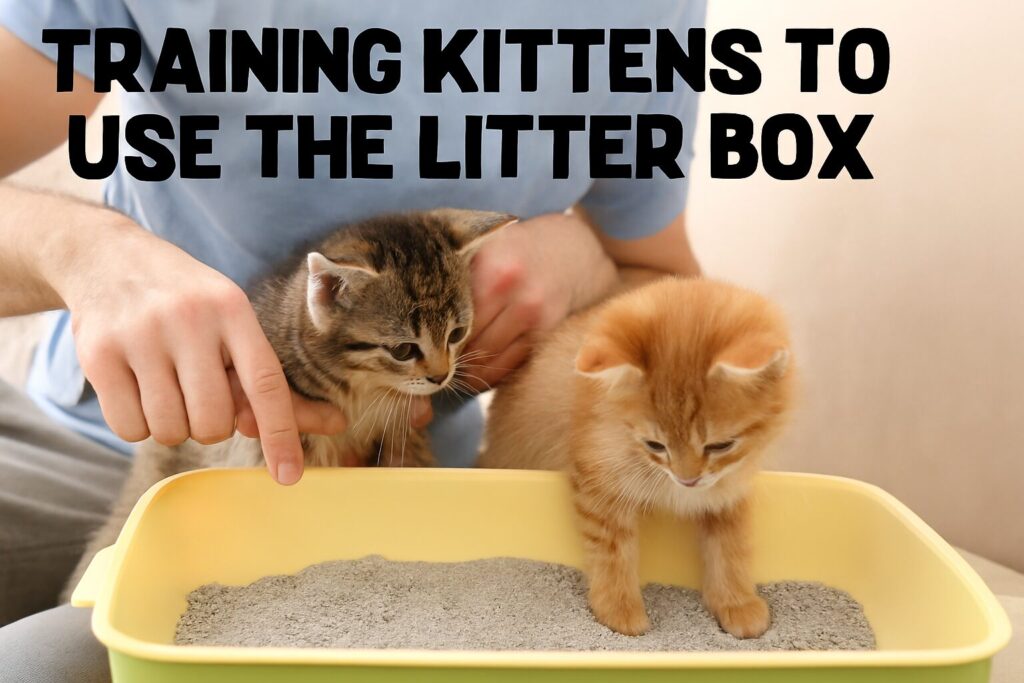
Most kittens have the instinct to bury their own waste, making litter box training a relatively easy part of having a young kitten. However, understanding how to support this behavior can make the difference between success and a lot of frustrating accidents.
Whether you’ve just brought home a tiny kitten or are just preparing to get one, this comprehensive guide can walk you through everything you need to know about litter box training.
Understanding Kitten Instincts
Kittens normally learn how to go potty from their mother when they’re about 3 to 6 weeks old. However, when you get your kitten, it is your responsibility to get him or her used to the new litter box in a new area and new home. Your primary role is to provide the right setup and gently guide them toward consistent habits.
Even very young kittens can begin using the litter box, though they may need a little help getting in and out of the box initially. If you’re adopting a kitten younger than eight weeks, you may need to offer a little extra assistance during the starting phase.
This is particularly true for Persian Cats, whose short legs can make it harder to climb into litter boxes with high sides. These playful and affectionate kittens can thrive in small spaces but need thoughtful litter box access due to their stature. Providing a lower entry point can prevent accidents and encourage consistent use from the beginning.
Setting Up for Success
Choose a shallow litter box that your kitten can easily enter and exit without climbing. Standard adult-sized boxes can be intimidating and physically challenging for tiny kittens, so look for boxes with sides no higher than two to three inches, or consider using a small cardboard box lined with a plastic bag as a temporary starter solution before you transition your kitten to a full-sized litter box.
Place the litter box in a quiet, easily accessible area that is away from your kitten’s food and water bowls. Cats instinctively avoid eliminating near their eating areas, so this separation is crucial. Keep it away from noisy appliances or areas which could make your kitten nervous. Make sure you have a litter box on every floor and you have it in a ratio of 2 litter boxes to 1 cat.
When selecting litter, start with unscented, clumping clay litter or a fine-grained natural alternative. Kittens are sensitive to strong smells, and heavily perfumed litters can be off-putting. Avoid crystal or large-pellet litters in the beginning, as these can be uncomfortable for tiny feet.
Fill the box with about two inches of litter, which should be enough to allow digging and covering behavior.
Also Read: How Many Litter Boxes for 2 Cats? Unlock a Happier Home!
The Training Process
Kitten Litter Box Training (Simple Steps)
- Set up a shallow, unscented litter box in a quiet spot
- Fill with 1–2 inches of fine-grain litter
- Introduce the kitten to the box and let it explore
- Place the kitten in the box after waking, eating, or playing
- Praise gently after successful use
- Scoop daily and clean the box weekly
- Use an enzymatic cleaner for accidents and redirect calmly
- Add extra boxes if you have multiple kittens
When you first bring your kitten home, introduce them to the litter box immediately. Gently place them inside and let them explore. You can scratch at the litter with your finger in a digging motion, which most kittens will try to follow.
For the first few days, bring your kitten to the litter box immediately after waking up, shortly after eating or drinking, and after play time. These are normally times when they need to eliminate. If you notice signs that your kitten needs to go, such as when she sniffs around, circles, or scratches on the floor, quickly bring her to the litter box.
Offer gentle praise when your kitten successfully uses the litter box. A small pat or scratch should suffice. If accidents happen, simply clean the area thoroughly with an enzymatic cleaner to remove the smell, and place the kitten in the litter box so she associates it with peeing or pooping.
Maintaining the Litter Box
Scoop the litter box at least once daily, and twice daily for young kittens. Cats are clean creatures, and a dirty box is one of the primary reasons they’ll seek alternative spots to go. Empty and wash the box with mild soap and water every week, replacing all the litter.
By the time the kittens are around 4 to 6 months, they should be big enough to transition to an adult-sized litter box. This can be made easier by placing the boxes side by side and allowing your kitten to choose. Eventually, they will choose the bigger one when the smaller one becomes too cramped.
Troubleshooting Common Issues
Despite their instincts, kittens can still experience some challenges. If your kitten struggles with the process or avoids the litter box, you may need to consult with your veterinarian to determine if your cat has any underlying medical issues. Urinary tract infections and digestive issues can cause your kitten to avoid the litter box.
If health issues are ruled out, examine your setup. Is the box too small, too dirty, or in a stressful location? Is the litter type uncomfortable or strongly scented? Some kittens prefer certain litter textures or need complete privacy, while others prefer an open box in a visible area.
For kittens who like to go near the litter box but not inside it, it might be because the box’s edges are too high. You may need to provide an extra step to make it easier for her.
Also Read: Will Cat Litter Burn? 7 insights for Cat Owners
Multiple Kittens and Long-Term Habits
If you have multiple kittens or cats, make sure you have one litter box per cat plus one extra. This will prevent them from fighting and ensure that your kitten always has access to a clean litter box.
The habits you establish during kittenhood typically last a lifetime. By creating positive litter box experiences now, you’re setting that cat up for a lifetime of good litter habits.
Conclusion
Training kittens to use the litter box is all about supporting their instincts with gentle guidance and a good environment. With the right setup, consistent gentle direction, and patience, most kittens master this essential skill quickly and easily.
Accidents are part of the learning process, but maintaining a calm and positive approach will help your kitten develop into a confident, well-trained cat. The effort you invest in these early weeks will pay off in the long run—especially when paired with daily play and mental enrichment at home, which help create a happy, balanced pet in every way.
FAQs
Q1. How old should a kitten be to start litter training?
Most kittens learn from their mom between 3–6 weeks, but you can start encouraging box use as soon as you bring them home. Kittens younger than 8 weeks may need extra help getting in and out.
Q2. How long does litter training take?
Many kittens learn within days to 2 weeks with consistent guidance; outliers can take longer, especially if stressed or if there’s a medical issue.
Q3. What type of litter is best for kittens?
Use unscented, fine-grain clumping or a natural fine litter. Avoid strong fragrances, large pellets, and crystal litters at first.
Q4. How deep should the litter be?
About 1–2 inches (2.5–5 cm). Enough to allow digging, but not so deep that they sink or are uncomfortable.
Q5. Are covered litter boxes okay?
Covered boxes can trap smells and frighten some kittens. Start with an open box; you can try covering it later if the kitten prefers privacy.
Q7. My kitten is going just outside the box — what should I do?
First, clean the spot with an enzymatic cleaner to remove odor. Then move the kitten to the box after the accident and watch for triggers: dirty box, wrong litter, stressful location, or medical issues.
Q8. When can I switch to an adult litter box or a different litter?
Around 4–6 months, you can offer a larger box. When changing litter type, make the transition gradually by mixing small amounts of the new litter with the old.
Q9. What if my kitten never uses the litter box?
First, rule out medical issues with a vet. Then, audit the environment: try a different box, litter, location, and increase scooping frequency. Consider consulting a cat behaviorist for chronic problems.
Q10. My kitten scratches next to the box but not inside — why?
Edges might be too high or litter too deep/texture wrong. Try a lower-entry box or shallower fine-grain litter.


